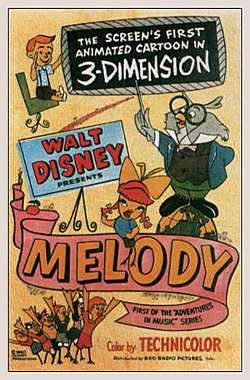Adventures in Music Duology

Two interesting short subjects made during the late years of The Golden Age of Animation (or the beginning years of The Dark Age of Animation, depending on one's point of view), the Adventures In Music duology -- Melody and Toot Whistle Plunk and Boom -- are two popular 1953 shorts in the Classic Disney Shorts lineup. While they feature none of the standard Disney cast, they are noteworthy for four reasons:
- Melody was the very first cartoon to take advantage of 3D glasses.
- Toot Whistle Plunk and Boom was the very first cartoon short subject to take advantage of the then-new widescreen CinemaScope process (Disney's first feature film to use it was Lady and the Tramp, however).
- Both have very stylized animation, obviously riding off the sharp, flat UPA fashion of the 1950s.
- Toot Whistle Plunk and Boom is one of The 50 Greatest Cartoons.
Both shorts are well remembered for their catchy music and their striking layout and character design. However, Walt Disney himself disliked the animation of the shorts. Allegedly, they were both made by Ward Kimball while Disney himself was off in Europe. After Disney won an Oscar for Toot Whistle Plunk and Boom, he went up to Ward Kimball and told him, "No more of this UPA crap." (Note that Walt was suspicious of artsy people like the UPA, many of whose artists had been involved in a 1941 strike at his studio.)
Both shorts are included on the Fantasia 2000 DVD, as well as the Walt Disney Treasures: Disney Rarities DVD set. And of course, they had a second life providing shell material for the long-running Disney Sing Along Songs videos.
- Anthropomorphic Animal
- Dunce Cap: Bertie Birdbrain wears one of these.
- Limited Animation
- Miscellaneous Disney Shorts
- The Owl-Knowing One
- Running Gag: The strings breaking during the "Plunk" section of Toot Whistle Plunk and Boom.
- The Runt At the End: The last character to sit down is smaller than the rest.
- Simpleton Voice: The dunce bird.
- Talking Animal
- Vocal Dissonance: The Runt At the End is a bass, whereas the rest are sopranos and tenors.